
ANSYS Polyflow
.pdf
vk.com/club152685050 | vk.com/id446425943
 Исправленные ошибки и ограничения
Исправленные ошибки и ограничения
Со всеми исправленными ошибками и ограничениями Вы можете ознакомиться в документе Resolved Issues and Limitations документации ANSYS.
 Известные проблемы и ограничения
Известные проблемы и ограничения
Все известные ошибки и ограничения перечислены в документации в пункте Known Issues and Limitations раздела
ANSYS Viewer User's Guide.
51

vk.com/club152685050 | vk.com/id446425943
Раздел 7 – Обновления ANSYS Discovery
7.1 ANSYS Discovery AIM
 Прочностной анализ
Прочностной анализ
•В шаблонах доступен модальный анализ с предварительным нагружением.
•Доступна таблица собственных частот и форм. Она автоматически создается в шаблоне Structural и позволяет параметризировать собственные частоты.
•В топологической оптимизации доступна валидация проекта.
•Теперь доступна идентификация всех контактов, шарниров или пружин для выбранного тела или тел. Необходимо нажать правой кнопкой мыши или выбрать фильтр в таблице контактов.
•Ссылки теперь позволяют просмотреть данные о контактах, шарнирах или пружинах.
•При наличии лицензии Mechanical Enterprise или CFD Enterprise доступна передача шарниров в Mechanical через среду Workbench (лицензия Discovery AIM не поддерживает эту возможность)
 Магнитный анализ
Магнитный анализ
•Для обработки результатов электромагнитного анализа доступна визуализация компонентов вектора магнитной плотности, интенсивности и плотности тока.
•Для задач электромагнитного моделирования с постоянным магнитом, для материала теперь отображается направление коэрцитивной силы, которое позволяет визуально верифицировать направление и упростить настройки модели с постоянным магнитом.
 Механика жидкости и газа
Механика жидкости и газа
•Контекстное меню было добавлено в анализ механики жидкости и газа для падения давления, расчете сил (сопротивления, скольжения) и массового расхода для упрощения добавления результатов.
•Улучшения были сделаны для шаблона механики жидкости и газа в области использования определения физики и обеспечения доступности выбранных материалов для каждого домена.
•Появилась возможность проводить расчет литья под давлением в AIM.
•Доступны специализированные граничные условия для полимерной экструзии твердотельной модели без изменения геометрии или сетки.
 Общие нововведения
Общие нововведения
•Настройка конечно-элементной модели на основании физики помогает упростить и автоматизировать процесс настройки. Это устраняет необходимость задания параметров сетки, и вместо этого соответствующая сетка генерируется автоматически, основываясь на предопределенных настройках для каждой дисциплины.
•Быстрый предпросмотр результатов на основании предварительных настроек дисциплины.
•Запись движений на экране и их экспорт в файл видео.
•Улучшен шаблон, обеспечивающий обмен данными с Discovery Live. Такие граничные условия, как момент, опора без трения, массовый расход и тепловой поток передаются из Discovery Live в AIM автоматически.
52

vk.com/club152685050 | vk.com/id446425943
 Ограничения
Ограничения
Все известные к выходу этого документа ограничения представлены в Knowledge Resources > в онлайндокументации.
7.2 ANSYS Discovery Live
ANSYS Discovery Live обеспечивает интерактивное численное моделирование и тесно связано со средствами прямого геометрического моделирования для моментального исследования конструкции и быстрой разработки первоначального варианта изделия.
Обновления в этой версии стремятся сделать процесс моделирования быстрее и проще, чем это было ранее. Теперь можно тратить больше времени на более тщательное изучение концепций, чем на сам процесс расчета и моделирования.
Новые возможности ANSYS Discovery Live 19.1 включают:
•Физика – серьезные улучшения с точки зрения механики жидкости и газа: в 10 раз точнее вычисление давления, малых пограничных слоев, сглаживание результатов и результатов вдоль свободной стенки.
•Результаты – новый интерфейс отображения результатов, новые типы и динамическая визуализация для позиционирования результатов и масштабирования
•Пользовательский/графический интерфейс – изменения инструментов и ленты позволяет использовать программное обеспечение на интуитивно понятном уровне
•Граничные условия – обновлененные граничные условия предоставляют больше настроек и облегчают использование
•Установка/Лицензирование – теперь можно изоливать настройки для установки SpaceClaim, Discovery Live
и SCDM
•Работа с фасеточной геометрией
53
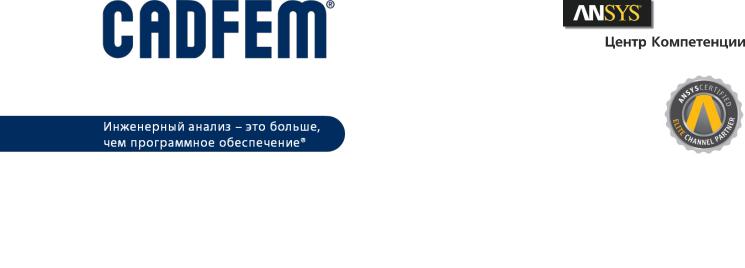
vk.com/club152685050 | vk.com/id446425943
|
|
www.cadfem-cis.ru |
www.ansys.com |
Москва |
+7 (495) 644-06-08 |
111672, г. Москва, |
|
ул. Суздальская, д. 46, офис 203 |
|
Санкт-Петербург |
+7 (812) 313-19-17 |
195197, г. Санкт-Петербург, |
|
Кондратьевский пр., д. 15, корпус 3, |
|
б/ц «Фернан Леже», офис 322 |
|
Самара |
+7 (846) 279-49-71 |
443069, г. Самара,
ул. Авроры, д. 110, корпус 1, офис 406
Екатеринбург |
+7 (343) 385-04-20 |
620049, г. Екатеринбург, |
|
ул. Софьи Ковалевской, д. 3, офис 401 |
|
Новосибирск |
+7 (383) 251-01-84 |
630007, г. Новосибирск, |
|
ул. Советская, д. 5, |
|
б/ц КРОНОС, блок Б, офис 641 |
|
Ростов-на-Дону |
+7 (928) 101-67-56 |
© ANSYS, Inc., ЗАО «КАДФЕМ Си-Ай-Эс», 2018
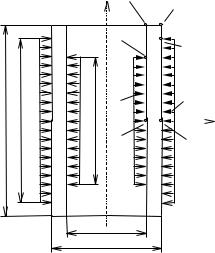
vk.com/club152685050 | vk.com/id446425943
Анализ НДС внутренней втулки гидростата на давление 200 МПа
Выполнить анализ НДС внутренней втулки контейнера гидростата, скрепленной обмоткой из высокопрочной ленты. Изнутри на втулку действует рабочее давление p, снаружи – давление витков скрепляющей обмотки p0.
Исходные данные для расчета:
(400,800) |
|
|
|
Z |
|
|
(500,800) |
|
|
3 |
|
(400,670) |
|
|
27 |
4 |
|
|
|
|
|
(500,720) |
|
|
|
|
|
|
|
5 |
|
p |
|
1 |
p |
|
0 |
||
h |
l0 |
l |
(400,0) |
R |
|
|
|
(500,0) |
d
D
Рис. 1
Материал втулки: |
сталь 5ХНМ; |
Модуль упругости: |
E = 2,1·105 МПа; |
Коэффициент Пуассона: |
= 0,3; |
Внутренний диаметр: |
d = 800 мм; |
Наружный диаметр: |
D = 1000 мм; |
Высота втулки: |
h = 1600 мм; |
Длина зоны действия давления p: |
l = 1340 мм ; |
Внутреннее давление: |
p = 200 МПа; |
Давление в стыке обмотки и втулки: |
p0= 148 Мпа; |
Длина зоны действия давления p0: |
l0 = 1440 мм. |
Как следует из расчетной схемы (рис. 1), задача может быть решена в осесимметричной постановке, причем достаточно выполнить анализ для 1/4 полной границы поперечного сечения контейнера. Число участков границы – 5. Координаты (x,y) начальных и конечных точек участков указаны на рис. 1 в круглых скобках. На участках 1 и 5 действует нагрузка в виде нормального давления величиной p0 и p соответственно.
Пошаговое решение задачи
Установка типа решения (шаг не обязателен)
Main Menu – Preferences – Structural – h-Method
Выбор типа элементов
Main Menu – Preprocessor – Element Type Add/Edit/Delete – Add – Structural Solid –
Quad 4node 42 |
OK |
Main Menu – Preprocessor – Element Type Add/Edit/Delete – Options – |
|
K3=Axisymmetic |
OK |
Задание свойств материала
Main Menu – Preprocessor – Material Props – Isotropic –
MatNum=1 OK EX=2.1e5; MU=0.3 OK
Создание твердотельной модели
Main Menu – Preprocessor – Create – Areas – Rectangle – By Dimensions –
X1=400 X2=500 Y1=0 Y2=670 |
Apply |
X1=400 X2=500 Y1=670 Y2=720 |
Apply |
X1=400 X2=500 Y1=720 Y2=800 |
OK |
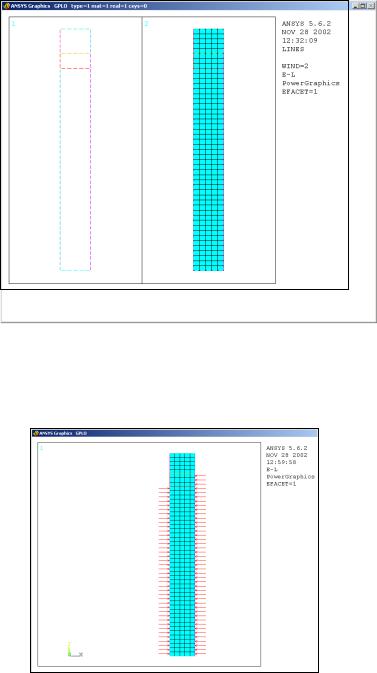
vk.com/club152685050 | vk.com/id446425943
"Склейка" поверхностей
Main Menu – Preprocessor – Operate – Glue – Areas –
Pick All
Создание конечно-элементной модели
Main Menu – Preprocessor – Mesh Tool
Line Set; Areas (Quad – Mapped;) Mesh – Pick All
5  5
5  3
3
 40
40
Приложение нагрузок
Назначение линии симметрии
Main Menu – Solution – Loads – Structural – Displacement – Symmetry B.C. – On Lines – указать нижнюю горизонтальную линию
Приложение давлений
Main Menu – Solution – Loads – Structural – Pressure – On Lines – указать линии
Решение
Main Menu – Solution – Current LS
OK
Просмотр результатов
Main Menu – General Postprocessor
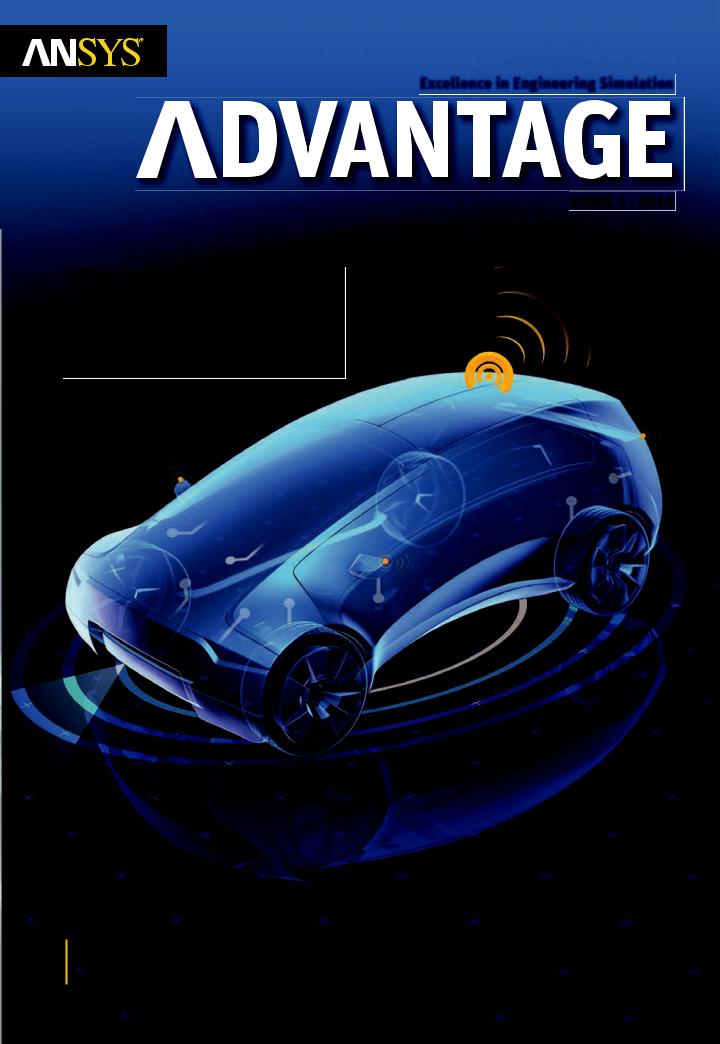
vk.com/club152685050 | vk.com/id446425943
Excellence in Engineering Simulation
ISSUE 1 | 2018
SPOTLIGHT ON
Autonomous
Vehicles
15 Drive Safely |
|
20 Safe Travels |
|
24 On the Radar |
|
|
|||
Identifying autonomous |
|
Ensuring dependable |
|
Pioneering reliable |
system weaknesses |
|
automotive electronics |
|
radar systems |

vk.com/club152685050 | vk.com/id446425943
PRESENTING SPONSOR
JUNE 17-20, 2018 | BOSTON, MA
EXPLORE NEXT GENERATION DIGITAL TWINS BUILT WITH ANSYS SIMULATIONS AND PTC THINGWORX ANALYTICS
$100 OFF ALL ACCESS PASS
USE PROMO CODE: DIGITALTWIN
LIVEWORX.COM

vk.com/club152685050 | vk.com/id446425943
EDITORIAL
THE FUTURE IS SELF-DRIVEN
Autonomous vehicles are poised to redefine the global automotive and aerospace industries, among others. But designing these complex products for the required level of safety and reliability represents an engineering challenge without precedence.
By Sandeep Sovani,
Director for the Global Automotive Industry, ANSYS
Who doesn’t get excited about the prospect of self-driving cars, aircraft and robotic vehicles? Once the stuff of science fiction movies and Saturday morning cartoons, autonomous vehicles are already becoming a reality — and will soon become commonplace.
Experts believe that the emergence of safe autonomous driving technology will completely reinvent the global automotive industry, replacing millions of privately owned cars with fleets of robo-taxis, similar to today’s Uber and Lyft — but completely electric and self-driving.
While 2020 is the generally agreed-upon target for the first commercial release of autonomous cars, technology experts at RethinkX recently predicted that by
2030 — just 10 years later — a full 95 percent of U.S.passenger miles will be served by autonomous electric vehicles owned by companies providing Transportation
as a Service (TaaS).[1]
Similarly, unmanned aerial vehicles, or UAVs, are expected to revolutionize the shipping industry, as Amazon, UPS, Domino’s Pizza and other businesses aggressively invest in drone delivery capabilities.[2] A recent report from
Interact Analysis estimates that there will be a six-fold increase in drone shipments by 2022 to meet this demand, resulting in industry revenues that will grow from $1.3 billion in 2016 to $15billion in 2022.[3] Amazon has stated an ambitious goal: to eventually drone-deliver packages to consumers within 30minutes of order placement.[4]
While these are exciting predictions, the world’s engineers are tasked with the real, hands-on work of making this vision a reality in just a few short years. The design challenges associated with autonomous vehicles are unparalleled in the history of the transportation industry
— and the bar for safety and reliability has never been set higher.
For example, consider the problem of weather conditions. How can selfdriving cars sense highway lanes, other vehicles and pedestrians when thick fog or snow obscures their “vision” — i.e., their cameras, radar and lidar systems?
How can drones sense and respond to the unexpected wind shifts that are typical of urban landscapes as they attempt to make deliveries?
Before they can be successfully launched onto real-world highways and into actual skies, autonomous vehicles must be exhaustively tested and certified for safe operation. But how can this rigorous testing take place for such complex products, while still meeting ambitious deadlines — and delivering a healthy profit margin?
The answer is engineering simulation. To capture the market opportunity — and with human lives at stake — only simulation combines a high degree of speed and costeffectiveness with a high degree of product confidence. Multiphysics software from ANSYS enables companies to replace years of physical testing with simulations that replicate every aspect of autonomous vehicle performance under thousands of operating scenarios — all in a risk-free virtual environment.
As just one example, simulation allows product developers to view what sensors can actually “see” under a variety of real-world weather conditions
— instead of waiting months or years to conduct physical testing under every possible weather scenario.
By developing and testing critical components such as software, electronics and sensors in a riskfree virtual world, ANSYS customers
are among the leaders in the global drive toward vehicle autonomy. This issue of ANSYS Advantage highlights some of the advanced applications for simulation that are making the dream of autonomous vehicles a reality.
While it will be a few more years until our roads and skies are filled with self-driving cars and autonomous aircraft, these companies are shaping the future with their important product development work. Whatever your industry or product focus, we hope you will be inspired by the high-impact
simulations they are performing to solve the most challenging problems related to vehicle autonomy
References:
[1]USA Today. usatoday.com/story/ tech/news/2017/05/04/self-driving- electric-vehicles-make-car-ownership- vanish/101204980 (02/18/2018)
[2]Bloomberg. bloomberg.com/news/ articles/2017-06-21/the-future-of-drone- delivery-hinges-on-predicting-the- weather-block-by-block (01/11/2018)
[3]Interact Analysis. interactanalysis. com/drones-market-2022- predictions (01/11/2018)
[4]Opinion Outpost. opinionoutpost. com/en/blog/whats-going-on-with- amazons-delivery drones (01/11/2018)
© 2018 ANSYS, INC. |
ANSYS ADVANTAGE I 1 |
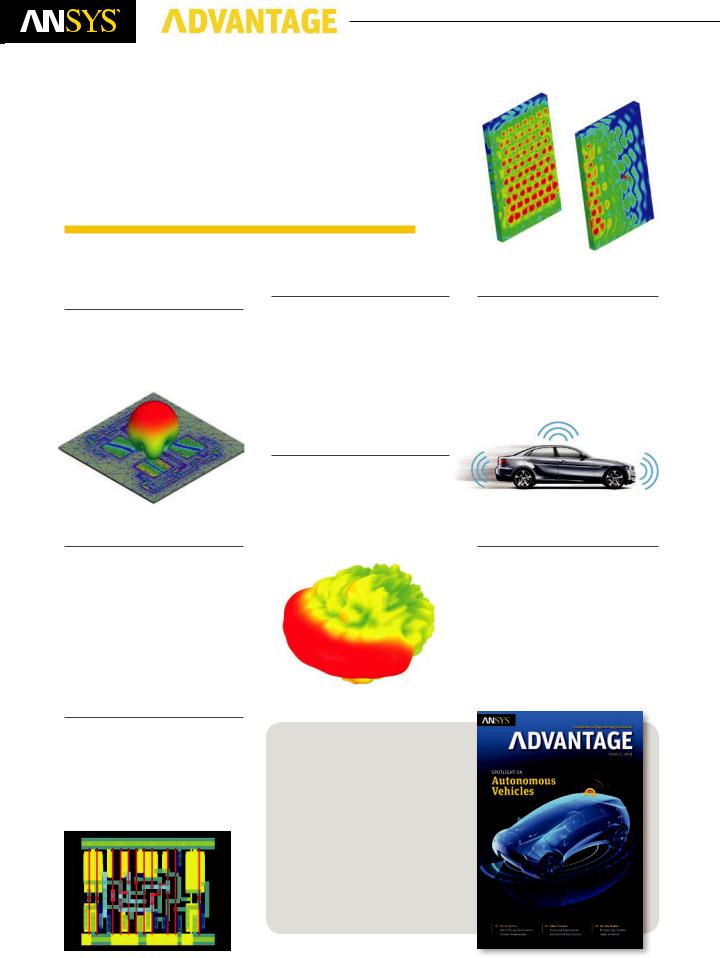
vk.com/club152685050 | vk.com/id446425943
Table of
Contents
Spotlight on Autonomous Vehicles
4
PERVASIVE ENGINEERING SIMULATION
Simulation Redefined
Today, simulation must be used daily, on every product and across the entire product lifecycle, to study and improve every aspect of performance.
20
SEMICONDUCTOR SIMULATION
Safe Travels
With the safety of a vehicle’s occupants increasingly dependent on electronics, engineering simulation is vital to avoid failure.
28
SENSOR SIMULATION
Autonomy on Roadways and Railways
Autodrive develops technology that uses plastic code markers on roads and rail tracks to precisely locate a vehicle to increase safety and traffic capacity.
10
BEST PRACTICES
Navigating Toward Full Autonomy
Engineering simulation is critical in the drive toward fully autonomous vehicles.
15
SOFTWARE AND ALGORITHM DEVELOPMENT
Drive Safely
It is impossible to program a computer to handle every possible driving scenario, so today’s autonomous driving systems feature programs that learn and think like human beings.
24
SENSOR SIMULATION
On the Radar
Autoliv uses ANSYS electromagnetic simulation software to evaluate radar integration scenarios to pioneer reliable systems and avoid costly design revisions.
32
SENSOR SIMULATION
Autonomous Vehicle Radar: Improving Radar Performance with Simulation
Ensuring that automotive radar systems operate reliably and provide accurate input to the control system requires use of advanced engineering simulation.
ABOUT THE COVER
The race is on to achieve full autonomy within the next few years, which means overcoming a host of advanced engineering challenges. This issue of ANSYS Advantage demonstrates how simulation is critical in the drive toward full autonomy.
2 I ANSYS ADVANTAGE |
ISSUE 1 | 2018 |
